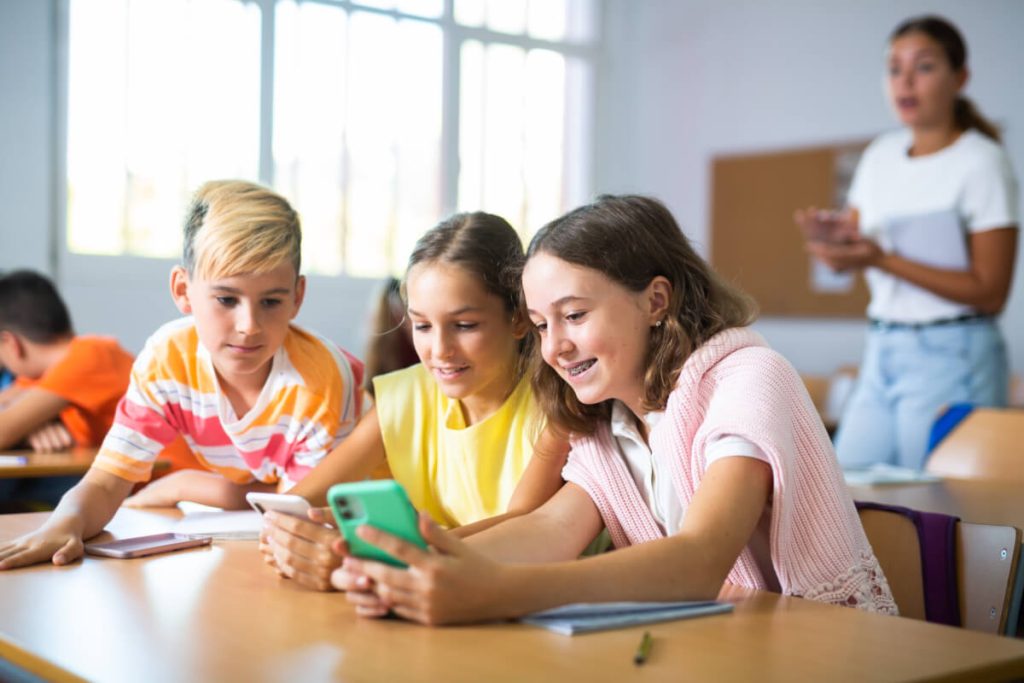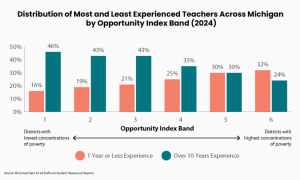

(Photo by BearFotos on Shutterstock)
In a nutshell
- Students spend an average of 92 minutes on smartphones during school hours, accounting for 27% of their total daily phone use
- Messaging and social media dominate school phone use, with Instagram users averaging 25 minutes during class time
- Parental restrictions show little impact on school phone use, suggesting school-based policies may be more effective
Parents’ rules fail: Study shows school restrictions may work better
SEATTLE — As schools nationwide grapple with smartphone policies, new research provides unprecedented and shocking insight into how teenagers use their phones during school hours. Using sophisticated tracking technology, researchers discovered that students spend an average of 92 minutes on their smartphones during a typical school day, with a quarter of students exceeding 2 hours of use.
Moving beyond simple screen time measurements, researchers deployed passive sensing technology to paint a detailed picture of how and when adolescents use their phones during the school day. Their findings raise important questions about the role of smartphones in modern education and their potential impact on learning.
Research led by Dr. Dimitri A. Christakis at Seattle Children’s Research Institute found that this school-day phone use accounts for approximately 27% of students’ total daily phone usage, which averages 5.59 hours. More revealing than the raw numbers is how students spend their phone time during school hours.
Social media and messaging dominate school-hour phone use, with Instagram leading social platforms. Instagram users in the study spent an average of about 25 minutes on the platform during school hours alone. Messaging and chat applications averaged 19.5 minutes of use during school hours, while video streaming services claimed about 17 minutes.


Looking at demographic patterns, older teens (ages 16-18) logged significantly more phone time during school hours compared to younger teens (ages 13-15), spending about 33 more minutes on their devices. Female students showed higher usage rates than male students, using their phones approximately 29 minutes more during school hours.
Parental attempts to limit screen time appeared to have little impact on school-hour phone use. Students with parental limits on screen time showed similar usage patterns to those without restrictions, suggesting that school-based interventions might be more effective than home-based rules.
Educational background of parents emerged as a significant factor. Students whose parents held bachelor’s degrees spent about 32 minutes less time on their phones during school hours compared to peers whose parents did not have college degrees. This correlation raises important questions about the role of family educational culture in shaping student technology habits.
The study, published in JAMA Pediatrics, also revealed interesting patterns among different demographic groups. Hispanic students showed significantly higher social media use during school hours compared to their white peers, spending about 25 more minutes on social platforms. Meanwhile, students identifying as LGBTQIA+ showed similar usage patterns to their non-LGBTQIA+ peers, with no statistically significant differences in overall phone use.
While smartphones offer potential benefits for learning and communication, these findings suggest their primary use during school hours may be misaligned with educational goals. More schools are expected to implement phone restrictions in the coming years, with research like this providing valuable data to inform those policy decisions.
Paper Summary
Methodology
Researchers used a sophisticated recruitment process through the research firm Ipsos to ensure diverse representation. Of 292 initially recruited participants aged 13-18 years, 117 provided sufficient data for analysis. These teens installed RealityMeter, an app that tracked smartphone usage patterns differently depending on device type. For Android users, it measured foreground activity directly, while for iOS users, it employed a VPN to infer app usage. Data collection occurred during May and September through November 2023, focusing on school hours (8:00 AM to 2:30 PM) on weekdays, excluding holidays.
Results
The study found that teens spent an average of 92 minutes on their phones during school hours, with a median of 67 minutes. This means while half of students used their phones less than 67 minutes, some heavy users pulled the average higher. The most used apps were messaging services (averaging 19.5 minutes), Instagram (24.6 minutes), video streaming (17.2 minutes), and music/podcasts (4.5 minutes). Older teens and female students showed significantly higher usage rates, while parental restrictions had virtually no impact on school-time phone use.
Limitations
Several important limitations affected the research. Since the study only tracked smartphone use, it likely underestimates total screen time, as students might also use tablets, laptops, or other devices. Technical limitations meant that native iOS apps couldn’t be fully tracked, potentially leading to underestimated usage for iPhone users. The sample size of 117 students, while providing valuable insights, suggests the need for larger studies to confirm these patterns across broader populations.
Discussion and Takeaways
This research provides the first comprehensive look at how teens actually use their phones during school hours, moving beyond simple screen time measurements to examine specific usage patterns. The findings suggest that most school-hour phone use centers around entertainment and social connection rather than educational purposes. With students spending nearly a quarter of their total daily phone time during school hours, the data raises important questions about appropriate phone policies in educational settings.
Funding and Disclosures
The Della Pietra Family Foundation partially funded this study. Several researchers reported receiving honoraria from organizations including the National Sleep Foundation and consulting fees from entities such as Children and Screens and Social Media Victims Law Center. Dr. Christakis, while serving as Editor of JAMA Pediatrics, was not involved in the review or acceptance of the manuscript.
Publication Information
This research letter, “Adolescent Smartphone Use During School Hours,” appeared online in JAMA Pediatrics on February 3, 2025. The collaborative study involved researchers from Seattle Children’s Research Institute, Stony Brook University, and Oregon Health & Science University.







